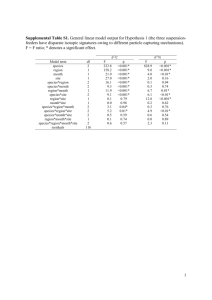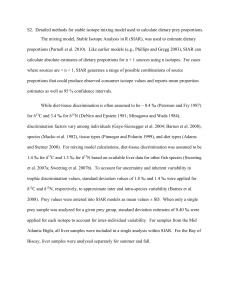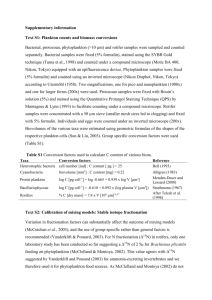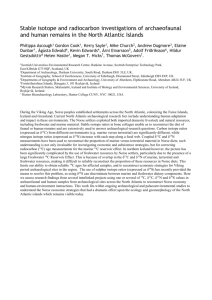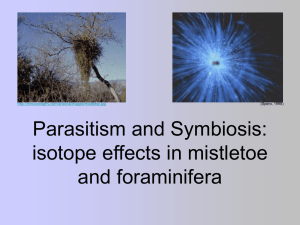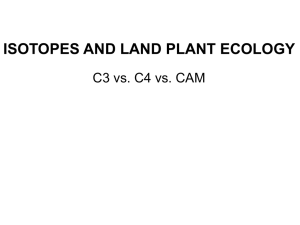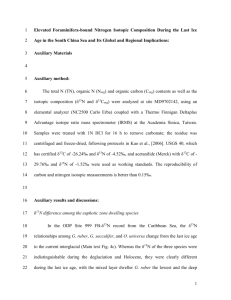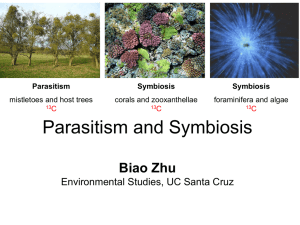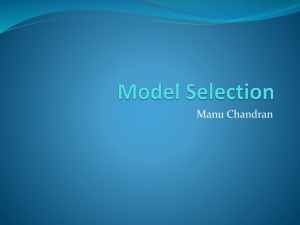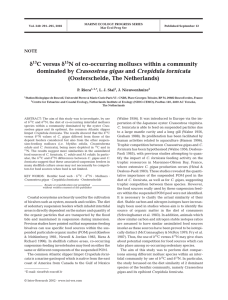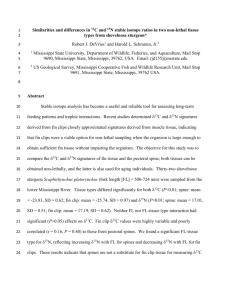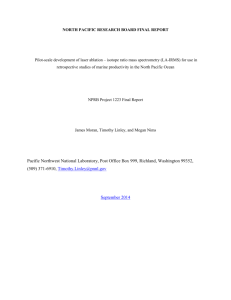etc2329-sm-0001
advertisement
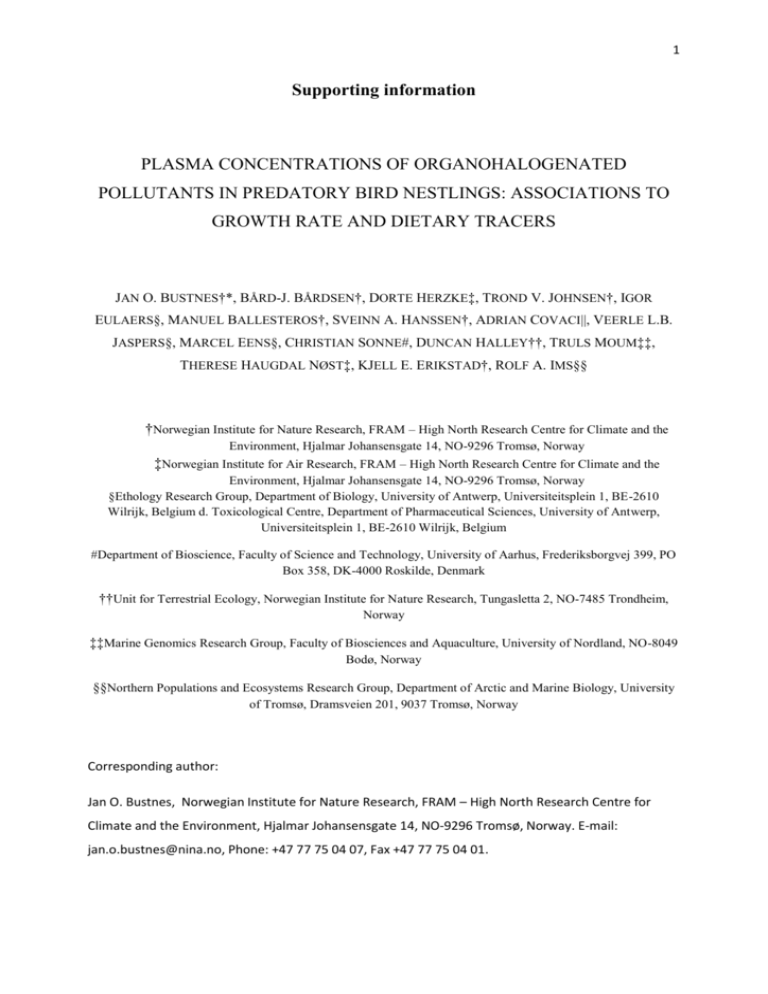
1 Supporting information PLASMA CONCENTRATIONS OF ORGANOHALOGENATED POLLUTANTS IN PREDATORY BIRD NESTLINGS: ASSOCIATIONS TO GROWTH RATE AND DIETARY TRACERS JAN O. BUSTNES†*, BÅRD-J. BÅRDSEN†, DORTE HERZKE‡, TROND V. JOHNSEN†, IGOR EULAERS§, MANUEL BALLESTEROS†, SVEINN A. HANSSEN†, ADRIAN COVACI||, VEERLE L.B. JASPERS§, MARCEL EENS§, CHRISTIAN SONNE#, DUNCAN HALLEY††, TRULS MOUM‡‡, THERESE HAUGDAL NØST‡, KJELL E. ERIKSTAD†, ROLF A. IMS§§ †Norwegian Institute for Nature Research, FRAM – High North Research Centre for Climate and the Environment, Hjalmar Johansensgate 14, NO-9296 Tromsø, Norway ‡Norwegian Institute for Air Research, FRAM – High North Research Centre for Climate and the Environment, Hjalmar Johansensgate 14, NO-9296 Tromsø, Norway §Ethology Research Group, Department of Biology, University of Antwerp, Universiteitsplein 1, BE-2610 Wilrijk, Belgium d. Toxicological Centre, Department of Pharmaceutical Sciences, University of Antwerp, Universiteitsplein 1, BE-2610 Wilrijk, Belgium #Department of Bioscience, Faculty of Science and Technology, University of Aarhus, Frederiksborgvej 399, PO Box 358, DK-4000 Roskilde, Denmark ††Unit for Terrestrial Ecology, Norwegian Institute for Nature Research, Tungasletta 2, NO-7485 Trondheim, Norway ‡‡Marine Genomics Research Group, Faculty of Biosciences and Aquaculture, University of Nordland, NO-8049 Bodø, Norway §§Northern Populations and Ecosystems Research Group, Department of Arctic and Marine Biology, University of Tromsø, Dramsveien 201, 9037 Tromsø, Norway Corresponding author: Jan O. Bustnes, Norwegian Institute for Nature Research, FRAM – High North Research Centre for Climate and the Environment, Hjalmar Johansensgate 14, NO-9296 Tromsø, Norway. E-mail: jan.o.bustnes@nina.no, Phone: +47 77 75 04 07, Fax +47 77 75 04 01. 2 Included Materials ____________________________________________________________________________________________ S1: Details regarding statistical analyses (Tables S1–S3 and Figures S1 and S2). S2: Descriptive statistics for the species and compounds (Tables S4 and S5) and estimates for the best models (Tables S6 and S7). SI 1: Details regarding statistical analyses GOSHAWK Selecting the models used for inference was performed in two different steps in these linear mixed models (LMEs). First, we defined the ‘full homoscedastic model’ where the most complex fixed effects structure was applied (i.e. a model that reflected our most complex a priori biological hypothesis). Second, we used this model, and defined a set of models with different variance functions in order to assess any heteroscedastic models, i.e. models that allow for different variance functions, would provide a better fit to our data compared to the ‘full homoscedastic model’ [e.g. Pinheiro and Bates (2000: table 5.1) and Zuur et al. (2009: ch. 4)]. Due to a limited number of observations per nest (see main text) we considered only two different variance functions: one with different variances per year (where the variance parameters represent the ratio of the SDs between each year and the first year) and one with no parameters and where body mass is used as a single variance covariate (see Table S1.1 for technical details). Third, we used the selected model from the second step, and defined a set of models with different fixed effects (i.e. models represented different a priori biological hypotheses; Table S1.2). Following Pinheiro and Bates (2000) we fitted models using restricted maximum likelihood (method REML) in the step 1-2 (as the fixed effects were constant), and using maximum likelihood (method ML) in step 2 where we had a set of candidate models consisting of different fixed effects. For each of the steps above we rescaled and ranked models relative to the model with the lowest AIC value (Δi denotes this difference for model i), and we selected the simplest model with a Δi≤1.5. Additionally, we used standard modelling diagnostics plots in order to assess if the selected models fulfilled the underlying assumptions for these models (e.g. Zuur et al. 2009). Random intercepts fitted per nest were selected in all analyses, but both homoscedastic 3 and hetereoscedastic models were selected in the different analyses: a homoscedastic models was selected in the analysis of PCB-153 whereas heteroscedastic models were preferred for the rest of the models (Table S1.1). Different fixed effects were also selected in the different analyses (Table S1.2), and details regarding the selected models are presented in the Appendix S2. All models were fitted to the exact same dataset: rows containing missing values for all predictors in the ‘full model’ were thus removed to the data fitted to all nested models. If the model used for inference did not include all predictors we did, however, fit this model to a dataset where rows containing missing values for the included predictors were removed. This means that the sample size (n) can be larger for the model used for inference (Appendix S2: Table S2.1 vs. Table S1.1) compared to the models showed in the model selection tables (Table S1.1-2). Confounding was assessed by checking for correlations between the different predictors, and a rather strong correlation between daily growth rate and body mass means that these effects could be confounded (Figure S1.1). We did, however, keep both as potential predictors as we had strong a priori expectations to both effects (the rationale behind this is outlined in the Introduction). Additionally, we tested whether the removal of either body mass or daily growth rate affected the direction or statistical significance of the remaining effect. The statistical significance did not change for either effect as: (1) the effect of body mass did not change from non-significant to significant and; (2) the effect of daily growth rate did not change from significant to non-significant (results not shown). Moreover, the sign of the effect of daily growth, i.e. the only significant effect in the original analyses (Appendix S2: Table S2.3 c-d), did not change (results not shown). In conclusion, a potential confounding between daily growth rate and body mass was indicated to be minor. WHITE-TAILED EAGLE Models selection was similar to what we did for goshawk, but as we applied linear models (LMs) instead of LMEs in these analyses we skipped step 1-2. The rationale for choosing LMs over LMEs is provided in the main text, but the rationale for not testing for issues related to heteroscedasticity was that none of these models seemed to violate any of the underlying assumptions as assessed through regular regression diagnostics. As in the goshawk analyses different fixed effects were also selected in the different analyses for this species (Table S1.3: see Appendix S2 for details regarding the selected models). As in the analysis above the sample size can differ between the model selected and used for inference and the candidate models shown in the model selection table (Appendix S2: Table S2.2 vs. Table S1.3). Confounding was also assessed in these analyses by checking for correlations between 4 different potential predictors, but as no high correlation were present we concluded that confounding between the included variables was unlikely to cause any large problems (Figure S1.2). REFERENCES Bolker, B. M., M. E. Brooks, C. J. Clark, S. W. Geange, J. R. Poulsen, M. H. H. Stevens, and J. S. S. White. 2009. Generalized linear mixed models: a practical guide for ecology and evolution. Trends in Ecology & Evolution 24:127-135. Pinheiro, J. C. and D. M. Bates. 2000. Mixed effect models in S and S-PLUS. Springer, New York, USA. Zuur, A. F., E. N. Ieno, and C. S. Elphick. 2010. A protocol for data exploration to avoid common statistical problems. Methods in Ecology and Evolution 1:3-14. Zuur, A. F., E. N. Ieno, N. J. Walker, A. Saveliev, A., and G. M. Smith. 2009. Mixed effects models and extensions in ecology with R. Springer, New York, USA. 5 Table S1. The relative evidence for each candidate model (i), in the assessment of homoscedastic vs. hetereoscedastic correlations structures, based on differences in AIC values (Δi) in the analysis of goshawk. The model in underlined in bold was selected and used for inference. Following Pinheiro and Bates (2000), these models were fitted with a restricted maximum likelihood (REML). The ‘full model’ with respect to the fixed effects is similar to model 1 in Table S1.2. Nest within Yeara Yeara Nesta Nest within Yeara Yeara Nesta Nest within Yeara Yeara varFixed (Body mass)b Nesta varIdent (Year)b Response Homoscedastic model PCB-153 p,p’ -DDE HCB PFOS 0 2.110 10.949 55.805 2.000 4.110 12.949 57.805 32.413 26.291 57.261 58.377 3.539 4.130 0 0 5.539 6.130 2.000 2.000 28.735 28.794 50.390 26.437 18.811 0 16.081 65.411 20.811 2.000 18.081 67.411 86.523 40.28 77.770 66.232 dfc 9 10 9 11 12 11 9 10 9 aThe syntax for the random effects (for models fitted via a call to the lme function) were as follows: (1) random = ~1|Nest for the ‘Nest’ model; (2) random = ~1|Year/Nest for the ‘Nest within Year’ model; and (3) random = ~1|Year for the ‘Year’ model. bThe syntax for the different variance functions (for the hetereoscedastic models fitted via a call to the lme function) were as follows: (1) weights = varIdent(form = ~1|Year) for the ‘varIdent (Year)’ model; and (2) weights = varFixed(form = ~ Body mass) for the ‘varFixed (Body mass)’ model. cdf denotes the number of parameters, whereas the number of observations (n) was 58 in all analysis except for PFOS where n = 53. 6 Table S2. The relative evidence for each candidate model (i), in the assessment of different fixed effects, a based on differences in AIC values (Δi) in the 1 2 3 4 5 6 7 8 9 10 11 12 13 14 15 16 aThis bdf x x x x x x x x x x x x x x x x x x x x x x x x x x x x x x x x x x x x x x x x x x p,p’ -DDE HCB PFOS Year δ15N PCB-153 δ13C Daily growth rate i Body massa analyses of goshawk. The model in underlined in bold was selected and used for inference. Following Pinheiro and Bates (2000), these models were fitted with a maximum likelihood (ML), whereas the final model was re-fitted with a REML. x x x x x x dfb Δi dfb Δi dfb Δi dfb Δi 9 7 6 5 4 6 5 5 6 7 8 6 7 7 8 8 2.782 0.051 5.340 8.765 9.413 11.936 3.591 5.239 3.123 11.423 2.668 0 4.863 8.517 8.720 4.514 9 7 6 5 4 6 5 5 6 7 8 6 7 7 8 8 1.658 2.337 7.074 18.423 16.625 15.028 11.119 5.505 13.119 16.270 0 0.393 8.106 6.175 7.079 9.958 11 9 8 7 6 8 7 7 8 9 10 8 9 9 10 10 2.754 2.914 1.874 0.419 6.128 7.014 6.250 7.968 1.758 0.000 8.843 7.801 7.199 8.921 1.552 1.464 11 9 8 7 6 8 7 7 8 9 10 8 9 9 10 10 2.883 1.564 0.140 0 2.170 3.203 2.827 1.865 1.311 1.317 3.801 2.634 4.044 2.848 1.369 2.710 predictor was kept in all models based on our a priori expectations. denotes the number of parameters, whereas the number of observations (n) was 58 in all analysis except for PFOS where n = 53. 7 Table S3. The relative evidence for each candidate model (i), in the assessment of different fixed effects, a based on differences in AIC values (Δi) in the 1 2 3 4 5 6 7 8 9 10 11 12 13 14 15 16 aThis bdf x x x x x x x x x x x x x x x x x x x x x x x x x x x x x x x x x x x x x x x x x x p,p’ -DDE HCB PFOS Year δ15N PCB-153 δ13C Daily growth rate i Body massa analyses of white-tailed eagle. The model in underlined in bold was selected and used for inference. x x x x x x dfb Δi dfb Δi dfb Δi dfb Δi 8 6 5 4 3 5 4 4 5 6 7 5 6 6 7 7 1.545 1.735 1.062 3.740 5.708 8.740 7.584 1.262 5.685 6.353 0 2.646 10.732 1.493 3.119 8.022 8 6 5 4 3 5 4 4 5 6 7 5 6 6 7 7 0.014 2.772 4.908 7.027 9.642 11.063 11.558 5.702 7.994 7.394 0 5.341 12.461 6.053 6.636 6.506 8 6 5 4 3 5 4 4 5 6 7 5 6 6 7 7 4.065 1.919 5.305 15.365 13.453 5.942 15.250 3.825 17.046 5.751 2.306 0 7.743 3.738 5.544 6.839 8 6 5 4 3 5 4 4 5 6 7 5 6 6 7 7 5.291 3.673 1.734 0 4.469 4.639 5.952 6.407 1.999 1.863 5.447 7.947 6.149 3.504 3.354 3.855 predictor was kept in all models based on our a priori expectations. denotes the number of parameters, whereas the number of observations (n) was 30 in all analysis except for PFOS where n = 29. 8 Goshawk 200 0 -200 -1.0 400 -0.5 0.0 0.5 1.0 1.5 10 30 -400 200 -30 -10 growth rate Daily MassDevDay.sc -0.548 r 0 mass.sc mass Body 57 df 2 3 -400 p <0.001 p 0.091 p 0.161 1.0 r -0.036 r 0.127 0.0 df 57 p 0.789 1 0 δ15N dN15.sc 57 -3 -2 -1 df 57 df -0.185 r 0.222 r r 0.123 dC13.sc δ13C df 57 p 0.353 -1.0 d f 57 p 0.336 -30 -20 -10 0 10 20 30 -3 -2 -1 0 1 2 3 Figure S1. Pearson’s product-moment correlation (r) with associated degrees of freedom (df) and P-values (p) between continuous predictors in the analyses of goshawk. All variables were centered (i.e. subtracting the average). Red line shows linear relationship whereas the blue dotted line shows the same using a LOWESS smoother. 9 White-tailed sea eagle 1000 0 -2 2000 -1 0 1 -20 0 20 60 -1000 1000 2000 -60 MassDevDay.sc growth rate Daily -0.227 r 0 p 0.229 r 0.305 1 -1000 mass.sc mass Body 28 df 0.101 p 0.608 r 0.251 r 0.086 1 -3 p -1 dN15.sc δ15N 28 -2 df 0 -0.098 r 28 df 0.399 dC13.sc δ13C 0 r -2 -1 df 28 p 0.029 d f 28 p 0.650 df 28 p 0.181 -60 -40 -20 0 20 40 60 -3 -2 -1 0 1 Figure S2. Pearson’s product-moment correlation (r) with associated degrees of freedom (df) and P-values (p) between continuous predictors in the analyses of eagle. All variables were centered (i.e. subtracting the average). Red line shows linear relationship whereas the blue dotted line shows the same using a LOWESS smoother. 10 S2: Descriptive statistics for the species and compounds and results from model selections, including estimates Table S4. Descriptive statistics for the predictors included in the model selected and used for inference in the goshawk analyses (removing missing values similar as in the analysis presented in the main text). Predictor Average SD Median 25% quantile 75% quantile n PCB-153 Daily growth rate δ13C δ15N Body mass -21.496 7.106 580.259 0.646 1.663 209.399 -21.527 7.478 547.500 -22.095 5.924 432.500 -21.039 8.300 737.500 58 58 58 p,p’ -DDE Daily growth rate δ13C δ15N Body mass -21.496 7.106 580.259 0.646 1.663 209.399 -21.527 7.478 547.500 -22.095 5.924 432.500 -21.039 8.300 737.500 58 58 58 25.086 13.611 25.536 17.095 31.423 58 HCB Daily growth rate δ13C δ15N Body mass 580.259 209.399 547.500 432.500 737.500 58 24.609 13.849 25.000 17.000 29.688 53 576.226 220.617 550.000 430.000 730.000 53 Response PFOS Daily growth rate δ13C δ15N Body mass 11 Table S5. Descriptive statistics for the predictors included in the model selected and used for inference in the white-tailed eagle analyses (removing missing values similar as in the analysis presented in the main text). Response Predictor Average SD Median 25% quantile 75% quantile n Daily growth rate δ13C δ15N Body mass -16.454 1.085 -16.506 -17.162 -15.723 32 2627.031 1021.335 2645.000 2068.750 3362.500 32 p,p’ -DDE Daily growth rate δ13C δ15N Body mass -16.454 14.239 2627.031 1.085 0.924 1021.335 -16.506 14.351 2645.000 -17.162 13.860 2068.750 -15.723 14.856 3362.500 32 32 32 HCB Daily growth rate δ13C δ15N Body mass -16.454 14.239 2627.031 1.085 0.924 1021.335 -16.506 14.351 2645.000 -17.162 13.860 2068.750 -15.723 14.856 3362.500 32 32 32 83.752 34.257 86.667 57.511 103.590 31 PFOS Daily growth rate δ13C δ15N Body mass 2755.161 942.734 2700.000 2175.000 3375.000 31 PCB-153 12 Table S6. Estimates from linear mixed-effect models relating different POPs (PCB-153, p,p’-DDE, HCB and PFOS) in the blood plasma of goshawk nestlings to various predictors. All predictors were centred (i.e. subtracting the average) meaning that the intercept represents the predicted level of each pollutant at the average level for the predictor(s) included in each analysis respectively. The models presented here were re-fitted using all available data for the predictors included in the model used for inference (see Supplement S1 for details). Parameter (a) log e(PCB153) Fixed effects Intercept δ13C δ15N Body mass Random effects Among-nest SD Within-nest SE (residuals) (b) log e(p,p’ -DDE) Fixed effects Intercept δ13C δ15N Body mass Random effects Among-nest SD Within-nest SE (residuals) Variance function (varFixed) Proportional to body mass Estimate SE df 7.859 -0.372 0.215 6.97×10-5 0.199 0.156 0.080 0.001 31 31 31 31 <0.001 0.023 0.012 0.889 31 31 31 31 <0.001 0.001 0.012 0.009 0.916 0.476 8.238 -0.341 0.132 0.001 0.629 0.025 t 39.576 -2.384 2.686 0.128 R 2 lme = 0.889 n Observation = 58 n Groups = 24 0.136 0.093 0.049 3.63×10-4 60.795 -3.655 2.678 2.798 R 2 lme = 0.886 n Observation = 58 n Groups = 24 (c) log e(HCB) Fixed effects Intercept 6.176 0.159 32 38.834 Daily growth rate 0.015 0.005 32 3.119 Body mass 32 0.603 1.37×10-4 2.28×10-4 Random effects R 2 lme = 0.930 Among-nest SD 0.749 n Observation = 58 Within-nest SE (residuals) 0.277 n Groups = 24 Variance function (Different SD per year; 2008 as baseline) 2009 1.606 2010 0.445 (d) log e(PFOS) Fixed effects Intercept 2.804 0.235 28 11.941 Daily growth rate -0.009 0.004 28 -2.189 Body mass 28 0.469 8.84×10-5 1.88×10-4 Random effects R 2 lme = 0.529 Among-nest SD 0.990 n Observation = 53 Within-nest SE (residuals) 0.136 n Groups = 23 Variance function (Different SD per year; 2008 as baseline) 2009 14.919 2010 0.770 P <0.001 0.004 0.551 <0.001 0.037 0.642 Note: R2lme denotes the R2 for the relationship between the fitted values (i.e. model predictions) and the response variable. Consequently, it is a measure of the amount of variance in the response variable being explained by the model predictions. Even though this can be interpreted as a measure of model performance it cannot be used or interpreted equivalent to the R2 values presented in Table S2.4. 13 Table S7. Estimates from linear models relating different POPs (PCB-153, p,p’-DDE, HCB and PFOS) in the blood plasma of white-tailed eagle nestlings to various predictors. All predictors were centred (i.e. subtracting the average) meaning that the intercept represents the predicted level of each pollutant at the average level for the predictor(s) included in each analysis respectively. The models presented here were re-fitted using all available data for the predictors included in the model used for inference (see Supplement S1 for details). Parameter Estimate SE t P (a) loge(PCB153) Intercept 9.190 0.168 Body mass -1.4×10-4 1.7×10-4 -0.406 0.157 δ13C (F = 3.77; df = 2,29; P = 0.04; R 2 = 0.21) 54.714 -0.865 -2.586 <0.001 0.394 0.015 (b) loge(p,p’ -DDE) Intercept 9.228 0.479 -0.840 0.220 δ13C 0.569 0.209 δ15N Body mass -1.1×10-4 1.6×10-4 Year [2010] 0.436 0.529 Year [2011] -0.823 0.592 (F = 3.80; df = 5,26; P = 0.01; R 2 = 0.42) 19.277 -3.820 2.719 -0.661 0.823 -1.391 <0.001 0.001 0.012 0.515 0.418 0.176 (c) loge(HCB) Intercept 7.259 0.106 -0.511 0.111 δ13C 0.318 0.131 δ15N Body mass -1.9×10-5 1.1×10-4 (F = 2.28; df = 3,28; P < 0.01; R 2 = 0.44) 68.441 -4.607 2.420 -0.187 <0.001 <0.001 0.022 0.853 (d) loge(PFOS) Intercept 3.469 0.104 Daily growth rate -0.009 0.003 Body mass -6.4×10-5 1.1×10-4 (F = 3.81; df = 2,28; P = 0.03; R 2 = 0.21) 33.424 -2.761 -0.563 <0.001 0.010 0.578
